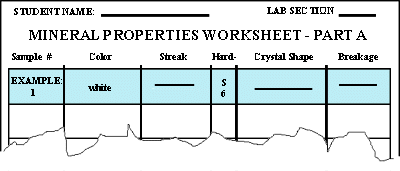- The Mineral Properties Worksheet has two Parts: A and B. Print out the two Parts before you begin your investigations.
- As you perform investigations to determine properties of mineral samples, record the results in the appropriate spaces on Parts A and B of the Form. The results may be numbers, words or brief phrases. If you have no information, draw a horizontal dash in the space.
- All results for samples with the same identifying number should be entered on the same horizontal row on the Form.
- Note the example shown on the right: It has only been possible to determine three properties of mineral # 1 from the available samples. The mineral is white, has a hardness of 6, and has striations. But these three properties are sufficient to distinguish albite from all other minerals on the Mineral Identification Charts.
- Record your results neatly as you will be submitting both Parts of the Form to the Corporation via your instructor. (Keep a copy of everything you submit.)
DETAILED INSTRUCTIONS
- Sample #: Record the number of the sample. There may be several samples of the same mineral, but they will all have the same number.
- Color: Record the color(s) of the samples: e.g., red, red-brown.
- Hardness: Record the hardness as S (soft), I (intermediate), or H (hard). You may also record the Mohs hardness number: e.g., 4; between 2 & 3.
- Crystal Shape: Record the crystal shape 'letter': e.g., shape 'D'.
- Breakage: Record the type of breakage: e.g., 'fracture'; 'cubic cleavage'.
- Density: Record the density you computed: e.g., D = 2.3
- Miscellaneous Visual Properties: Record all the terms that apply to the samples: e.g., opaque, metallic, massive.
- Miscellaneous Non-Visual Properties: Record all the terms that apply to the samples: e.g., salty, non-magnetic.
- MINERAL NAME: Compare the properties of the samples with the properties listed for minerals in the Mineral Identification Charts. Record the names of the mineral whose properties best match those of the samples.



